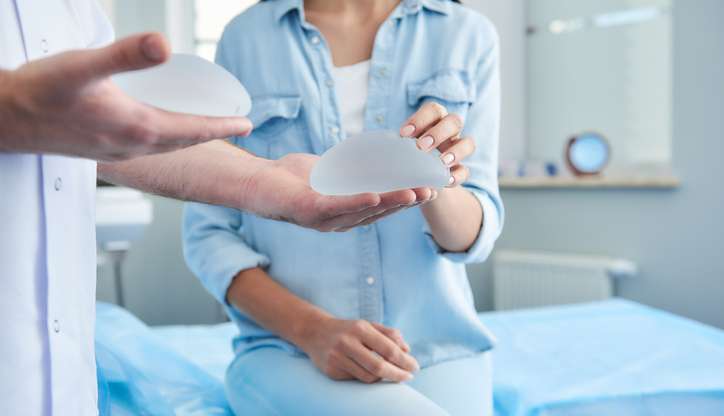SALINE VS. SILICONE BREAST IMPLANTS AND THE GUMMY BEAR IMPLANT
When it comes to breast augmentation surgery, your concerns are likely focused around the size of your implants and the final outcome; though, there are several questions you might want to consider, including:
- Should you choose saline, silicone, or silicone gummy bear implants?
- How much do breast implants cost?
- How long will I need to take off work following my breast augmentation surgery?
- Is over or under the muscle better for implant placement?
These are all valid questions and concerns — and we can answer each one of them! However, the hardest decision you’ll have to make is also one of the first: do you want silicone or saline breast implants? Your decision will ultimately come down to personal preference and aesthetic goals. But now, there’s a new option to consider. Gummy bear implants are a fresh take on silicone and were officially approved by the Food and Drug Administration (FDA) in 2012. They have become increasingly popular over the past few years. We’ll get to why later in this article. To help ensure you make an informed decision between silicone, saline and gummy bear, we’ve created a guide that covers all three.
Choose wisely. There are a few facts about breast implants that are simply universal. It’s important to separate fact and fiction when researching breast augmentation surgery information. Here’s what you need to know:
- They aren’t meant for a lifetime. Breast implants, regardless of what type you choose, aren’t meant to last forever. You’ll likely need to either replace or remove them at some point in your life. However, some implants do last longer than others, so be sure to ask your doctor.
- You aren’t alone. More than 310,000 women and teenagers underwent breast surgery to have their breasts enlarged with silicone or saline implants in 2018. Since 1997, the popularity of breast augmentation surgery has tripled!
- Surgery is still surgery, which means you’re at risk for infection. Proper after-care is essential to ensuring your breast implants remain unharmed. In addition to infection, your implants may become uneven, deflate, rupture, wrinkle, or any other number of possible complications. Be sure to discuss these with your doctor.
- Though complications from breast augmentation surgery have been documented, both saline and silicone breast implants are considered safe by the FDA.
- Speaking of aftercare, you’ll likely need MRI screening for silent ruptures. Just as a precaution for your health, MRI screenings every two years following the initial surgery can help protect you against rupture.
- Material isn’t the only thing you have to consider, you also have a say in the shape and size of your implant. For instance, if your goal is cleavage, fullness and an all-around more substantial lift, round implants are a popular choice. Whereas teardrop-shaped implants can help provide a more natural-appearing fullness.
- If you’re planning to have a child post-augmentation, breastfeeding could be a complication. This is more of an FYI than a warning — some women have been able to breastfeed just fine post surgery.
Now that you have a better idea of what you can expect from the breast implantation surgery as a whole, you have a better basis for choosing between silicone and saline. But before you make your choice, let’s go over the potential pros and cons of each implant material.
Saline Breast Implants
Saline breast implants consist of a silicone shell filled with sterile salt water (same consistency as water!). Saline implants were created as an alternative to silicone fill and became very popular in the 1990s and early 2000s. They can be pre-filled or filled during the implant operation. Today, saline implants account for 44-percent of all breast augmentation surgeries. Though these types of implants can come in different sizes, they are typically more round in shape (compared to the teardrop-shaped implants we mentioned previously). Saline implants have either smooth or textured shells.
Patients considering saline implants should be aware of a few advantages, such as less noticeable body scars and easy modification. When the surgeon fills the implant during the surgery, the initial incision is usually smaller than it would be for silicone implants. This also allows your doctor to change the size of your implants over time without needing an additional surgery due to a valve which your doctor can access with a small needle.
Saline implants are considered to be the safest option. An estimated 45-percent of women who choose silicone gel implants have to undergo reoperations within 10 years of the initial surgery. Using the same timeframe, only 20 to 26-percent of patients who choose saline have to undergo reoperation. Though rupturing is an uncommon event — the rupture rate is 3 to 10-percent at 10 years — if it were to happen the saline would be absorbed by the patient’s body. There would be no need to remove substantial breast tissue. This makes the rupture of a saline implant less problematic than silicone. Due to these lower repercussions, the FDA has approved saline implants for patients 18 years of age and older, compared to silicone implants’ minimum age of 22.
While complaints against saline implants are relatively low, the one common complaint has been that they don’t feel as natural as silicone implants. Variation in surgery technique and modified training has lessened these complaints, although the feel of saline is still different from that of silicone.
Silicone Breast Implants
Silicone breast implants consist of silicone shells filled with silicone gel, and can encompass a variety of breast implant types — including the increasingly popular gummy bear implant (more on this in a bit!). In previous years, silicone implants have been hailed as being more “natural looking and feeling” than saline implants, but also present more health risks if they begin to leak. In fact, from 1992 to 2006, the use of silicone implants was halted by the FDA pending further research because they didn’t feel the implants were safe enough for public use. If you choose silicone breast implants, you may need to make more frequent visits to your plastic surgeon. An MRI or ultrasound can assess the condition of your silicone breast implants and whether they’re functioning properly. The FDA recommends women with silicone breast implants should receive an MRI every two years to check for ruptures or leaks within the implant shell.
Unlike saline implants, a rupture in a silicone implant can go undetectable. That’s because roaming silicone gel may remain trapped in the fibrous tissue that forms around the implant. This is known as a silent rupture. Although leaking silicone gel isn’t thought to cause any major health concerns, such as breast cancer, over time the rupture may cause breast pain, hardening, swelling, tingling, numbness or an uneven appearance of the breasts. Silicone ruptures are not incredibly common — the 10-year rupture rate for primary augmentation is between one and 10-percent.
All that said, silicone implants have undergone a major overhaul: in addition to being perfectly safe, they have become widely popular. There are five types of silicone implants approved by the FDA. Each is manufactured slightly different, but the gummy bear is by far the most modern.
Gummy Bear Implants
The gummy bear implant is the newest choice on the block. Though it was introduced in the mid-2000’s, the FDA did not approve of them until 2012. Now, more than ever, women are seeking out gummy bear implants because of their natural look and feel. Because it’s a type of silicone implant, it’s only approved for adults over 22 years of age, or women of any age who are undergoing breast reconstruction following cancer. It is not approved for women who are pregnant or nursing. Gummy bear implants are great options for women who are looking for more volume in their breasts without the extreme shape of other options. These implants also provide a more natural droop to the bottom half of breasts.
The gummy bear breast implant has made waves due to its original teardrop shape. Yes, it’s still a silicone shell filled with silicone gel, but its shape design helps contribute to its stability. Traditional saline and silicone implants are typically round in nature, but the gummy bear’s additional cross-linking results in a firmer shell that holds its shape, even when cut in half — much like a gummy bear candy. Clever, right? Essentially, that means in the event of a rupture, a gummy bear implant retains its shape. And not only do they retain their shape compared to other types of implants, they also stay naturally soft. Shape retaining plus a natural feel is a win-win.
After years of studying gummy bear breast implants, which Dr. Love was a part of, the FDA has declared them safe and available to the public. While they add a more natural look to breast implants, they also require a larger incision during surgery. Like other implants, they may require additional surgeries in the future, and may become infected if not cared for properly. The gummy bear implant should not necessarily be considered “better” than the previous types of implants, just different to fit different needs: for women undergoing breast reconstruction, the gummy bear is ideal because it doesn’t require fitting around existing breast tissue.
Also, due to their strength, ruptures and leaks are less likely to occur in gummy bear implants than saline or other silicone options. But like their silicone counterparts, if leaks due occur they can be hard to detect. Regular MRIs and doctors visits are recommended to anyone who chooses gummy bear implants.
How do I choose my new Breast Implants?
Now that you know the basic differences between saline, silicone and gummy bear implants, you should be more prepared to make a decision on which options best suits your needs and lifestyle. However, this is an incredibly important decision! We recommend consulting with your plastic surgeon before making any final determinations.
Dr. Tim Love is a board-certified plastic surgeon and a leader in breast augmentation in Oklahoma City. Dr. Love was one of only 20 U.S. surgeons selected to participate in the FDA’s historic “CORE” gel breast implant study leading to the reintroduction of gel implants in the U.S. During this study, he implanted the first patient in the U.S.
If you would like to schedule a personal consultation, please give us a call at 405-751-5683 or toll-free at 866-751-5683.
Feel free to check out Dr. Love’s patient testimonials to see what his clients have been saying!









